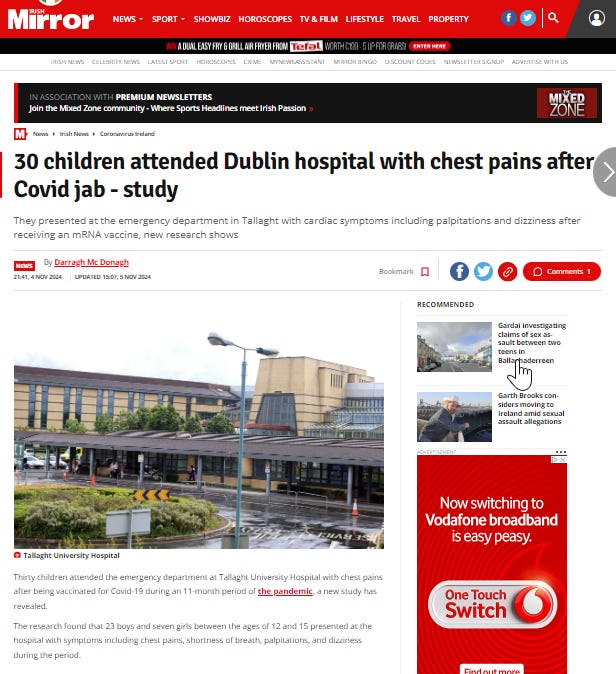Study from Ireland: concerns about cardiac effects of the covid injectables in children are being brushed under the carpet.
At least 1 in every 1000 children sought medical help for chest pain.
This article in the Irish Mirror has been subject of quite a bit of internet traffic today.
The actual study referred to - basically a retrospective review of children presenting with cardiac symptoms to one hospital in Dublin over an 11 month period after the covid injectable rollout - can be found here and below:
The authors seem remarkably unperturbed that 30 children aged 12 - 15 years old (out of a catchment area of say 30,000 12-15 year olds1, of whom say 20,000 received the injections) developed chest pain serious enough to warrant hospital investigation.
They measured troponin in 28 of the 30 children and found:
Twenty eight patients had a troponin T level performed, with the majority returning a normal value (<14ng/L).
Only 5 (17%) patients had an elevated troponin T, and these were only mildly elevated (14, 15, 16, 17, and 23ng/L).
2 of these patients with raised troponin had their troponin level re-measured soon after, showing normalisation of the value to below 14ng/L.
One wonders how doctors observing these effects could possibly not think to themselves that a key claim made by regulators - that the injected product was broken down in the arm without systemic effects - must have been false, with important safety implications.
There is much more that I could say about the apparent insouciance displayed by the medical profession in this paper towards inflicting harms on children in the absence of evidence of any possible benefit, but I will confine myself to just three comments:
1. The safe level for troponin is unknown.
In this paper published in Circulation, the authors stated that:
Even minimally increased cTnT may represent subclinical cardiac injury and have important clinical implications, a hypothesis that should be tested in longitudinal outcome studies.
As I wrote here for
:It is to be noted that as described here the cut-off of 13 pc/ml (based on the 99th percentile for a normal reference population) appears to relate to the use of troponin levels to determine a differential diagnosis of chest pain when a myocardial infarction (“heart attack”) is suspected - ie to answer the typical question facing ER doctors (and one which is not as easy to answer merely based on symptoms as many might imagine): “has there been cardiac involvement, or is this just indigestion?”
Because of the mechanism of a typical heart attack (blockage of an artery) you'd actually expect a heterogeneous response - either an amount of heart muscle has been damaged sufficient to result in high troponin elevation, or not (resulting in no elevation). Hence the use of a certain cut-off can reasonably reliably rule out an incident such as heart attack.
However, with myocarditis, we should surely be concerned with identifying any myocardial damage at all, not screening for MI as a differential diagnosis. In this context, a completely safe level is unknown. It may be that any elevation means there has been myocardial damage. Depending on where this is, it may be associated with an increased chance of suffering a fatal arrhythmia.
2. The patients seen in this hospital represent only those with chest pain, and likely only a proportion of those.
I wrote about a study of smallpox vaccination here. In this 2015 study they measured troponin before and after SPX vaccination of around 1000 healthy military personnel, with around 189 controls having received an influenza vaccine. The key points were that:
The frequency of subclinical cases of myocarditis may dwarf the clinical cases.
Myocarditis cases may be easily dismissed as musculoskeletal in origin.
Hence the conclusion of that article - that we simply didn’t know the size of the myocarditis iceberg.
Of course, as I reported here, subsequent published studies have confirmed that troponin becomes raised in around 2-3% of recipients, and we have no idea what the long terms effects of the myocardial injury which that suggests might be.
3. The observations made were after 2 doses - yet some children went on to receive more doses.
There are probably around 1m under 18s in Ireland, and around 8% received a booster, equating to around 80,000 children.



I wish I knew what the exact correct word or phrase is in the English language to describe the glib, smug, pretentious, callous and condescending attitude of the professional classes towards us useless eaters, whether it’s doctors and academics during the pandemic no now, or any other of their insane modern obsessions like war, transgender, LGBT, corruption etc.
Children shouldn’t have been vaccinated.
Nobody should have been vaccinated against self-limiting respiratory disease it was known from the beginning wasn’t a serious threat to most people.
See: What exactly is ‘COVID-19’? https://elizabethhart.substack.com/p/what-exactly-is-covid-19